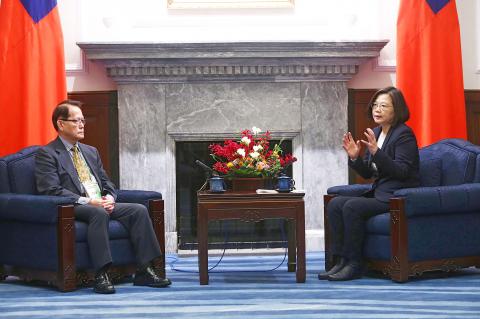The government is seeking to identify potential victims of the 228 Incident who were previously unrecorded, President Tsai Ing-wen (蔡英文) said yesterday, adding that a new report on the brutal crackdown would be issued later this year.
Tsai made the remarks while receiving an overseas group of family members of victims.
In her address to the group, she said that victims’ families have long been concerned about the progress of transitional justice, adding that without their reminders, the government would not be able to honestly face the important event in the nation’s history and reflect on it, nor would there be any progress.

Photo: CNA
Since the beginning of Taiwan’s democratization, the government has made a series of efforts to implement transitional justice, including admitting its wrongdoing, issuing apologies to the victims of the Incident, launching investigations and offering compensation, Tsai said.
However, the process of discovering the truth and pursuing justice has no end, she said, adding that the government has the responsibility to contribute more.
In the past two years, the government has been more attentive than ever to the work of transitional justice, she said.
The 228 Incident was triggered by a clash between government officials and an illegal cigarette vendor in Taipei on Feb. 27, 1947, leading to protests a day later that were violently suppressed.
The crackdown triggered a broader anti-government uprising that was put down by Chinese Nationalist Party (KMT) forces.
An estimated 18,000 to 28,000 people were killed during the crackdown, which lasted into early May that year, a 1992 probe commissioned by the Executive Yuan found.
From the legal side, the 2017 passage of the Act on Promoting Transitional Justice (促進轉型正義條例) offers solid legal ground for the implementation of transitional justice, Tsai said.
From an organizational perspective, the Transitional Justice Promotion Committee last year began its work and the 228 Memorial Foundation would continue to unearth details about the Incident and identify potential victims who were previously unknown, she said.
Through the National Human Rights Museum that officially opened last year, the public would have more opportunities to better understand the implications of transitional justice, she added.
“We will never forget and we will not stop” seeking the truth, seeking those accountable and promoting history education, Tsai said.
She said that she hopes family members of the Incident’s victims would continue to provide suggestions and participate in relevant discussions to more thoroughly implement transitional justice.

A magnitude 7.0 earthquake struck off Yilan at 11:05pm yesterday, the Central Weather Administration (CWA) said. The epicenter was located at sea, about 32.3km east of Yilan County Hall, at a depth of 72.8km, CWA data showed There were no immediate reports of damage. The intensity of the quake, which gauges the actual effect of a seismic event, measured 4 in Yilan County area on Taiwan’s seven-tier intensity scale, the data showed. It measured 4 in other parts of eastern, northern and central Taiwan as well as Tainan, and 3 in Kaohsiung and Pingtung County, and 2 in Lienchiang and Penghu counties and 1

A car bomb killed a senior Russian general in southern Moscow yesterday morning, the latest high-profile army figure to be blown up in a blast that came just hours after Russian and Ukrainian delegates held separate talks in Miami on a plan to end the war. Kyiv has not commented on the incident, but Russian investigators said they were probing whether the blast was “linked” to “Ukrainian special forces.” The attack was similar to other assassinations of generals and pro-war figures that have either been claimed, or are widely believed to have been orchestrated, by Ukraine. Russian Lieutenant General Fanil Sarvarov, 56, head

SAFETY FIRST: Double the number of police were deployed at the Taipei Marathon, while other cities released plans to bolster public event safety Authorities across Taiwan have stepped up security measures ahead of Christmas and New Year events, following a knife and smoke bomb attack in Taipei on Friday that left four people dead and 11 injured. In a bid to prevent potential copycat incidents, police deployments have been expanded for large gatherings, transport hubs, and other crowded public spaces, according to official statements from police and city authorities. Taipei Mayor Chiang Wan-an (蔣萬安) said the city has “comprehensively raised security readiness” in crowded areas, increased police deployments with armed officers, and intensified patrols during weekends and nighttime hours. For large-scale events, security checkpoints and explosives

‘POLITICAL GAME’: DPP lawmakers said the motion would not meet the legislative threshold needed, and accused the KMT and the TPP of trivializing the Constitution The Legislative Yuan yesterday approved a motion to initiate impeachment proceedings against President William Lai (賴清德), saying he had undermined Taiwan’s constitutional order and democracy. The motion was approved 61-50 by lawmakers from the main opposition Chinese Nationalist Party (KMT) and the smaller Taiwan People’s Party (TPP), who together hold a legislative majority. Under the motion, a roll call vote for impeachment would be held on May 19 next year, after various hearings are held and Lai is given the chance to defend himself. The move came after Lai on Monday last week did not promulgate an amendment passed by the legislature that